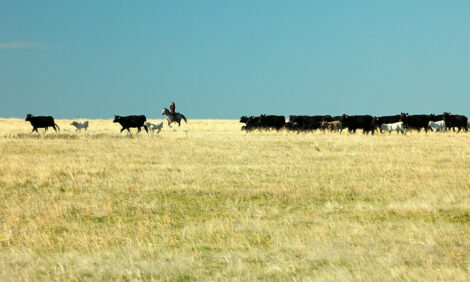



Renovating High-Traffic Areas With Annual and Perennial Ryegrass
US - Many areas in pastures are susceptible to severe damage between late fall and early spring, writes Lyndsay Jones from the University of Kentucky.High traffic areas such as feeding areas, sacrifice lots, alleyways, gateways and waterers are often bare and muddy this time of year, says Lyndsey, Master Grazer Coordinator.
To slow and reduce soil erosion, compaction, forage damage, and weed problems, these areas need to be renovated promptly. It is also beneficial for animal health to reduce muddy areas. Both annual (Italian) and perennial ryegrass are good options when renovating these areas, but annual ryegrass usually dies out during Kentucky (KY) summers.
These cool-season forages work well to renovate high traffic areas because they establish easier and more quickly than other common forage species. They are frequently used as a cover crop and can be useful when establishing new pastures or when reseeding old stands with more permanent forages.
The dense, shallow root system not only reduces erosion but also improves soil aggregate stability, reduces current compaction by breaking up dense soils, and helps to prevent future compaction.
Vigorous growth helps these forages to outcompete unwanted late summer and winter annuals. Annual ryegrass is more vigorous than perennial ryegrass, but provides only short term grass cover.
It will die out during the summer whether it is planted in the spring or the fall of the previous year.
The advantage of late summer or fall planting, is high quality late fall and early spring grazing. Perennial ryegrass is more susceptible to summer slump than other cool-season grasses, but with proper management (fertilization and rotational grazing) usually survives for 2-3 years in KY pastures. Some producers mix these two grasses to obtain quick cover from the annual ryegrass and longer term survival from the perennial ryegrass.
Seeding ryegrass for quick coverage not only reduces erosion potential but also provides a valuable forage. These grasses are often used for pasture, hay, or silage. If harvested at a vegetative state, ryegrass is high in digestibility.
Compared to other cool-season grasses, this species is also high in protein and can be a useful feed for livestock with high nutritional needs such as lactating and growing animals. Renovating bare areas with ryegrass provides a high quality forage as well as protecting the soil.
Management of ryegrass is similar to that of other cool-season grasses. Drilling seed into a firm seedbed is recommended for best seedling establishment. Ryegrass can be seeded in the late summer/fall or early spring.
It is possible to frost seed ryegrass by scattering seed on the soil surface in February but it is suggested that seed be drilled into the soil for maximum success. Fertilizer and lime should be applied according to soil test results. Doing split applications of nitrogen (40-60 lbs/ac) can be beneficial.
It is important to use high quality seed of a variety suited for the intended use. Using a winter hardy variety is suggested as this species is not highly tolerant of extremely cold temperatures. It is important to reduce competition from weeds and other unwanted species.
If possible, keep livestock or heavy traffic off newly seeded areas to allow for seedling establishment. Rotationally graze for maximum efficiency. Do not overgraze and allow for an adequate rest and regrowth period. See the following table for suggested management of ryegrass in Kentucky.
See the 2012 ryegrass variety trial report at http://www.ca.uky.edu/agc/pubs/PR/PR648/PR648.pdf.
TheCattleSite News Desk


